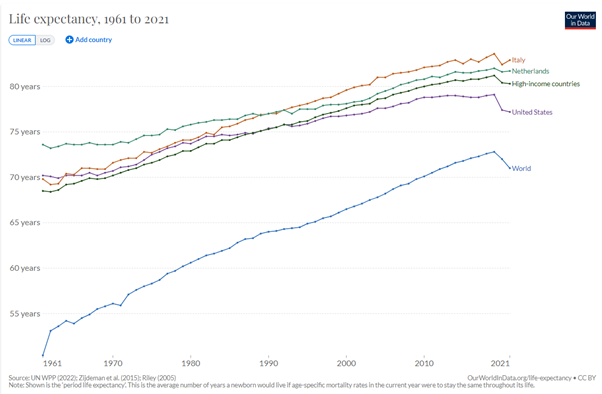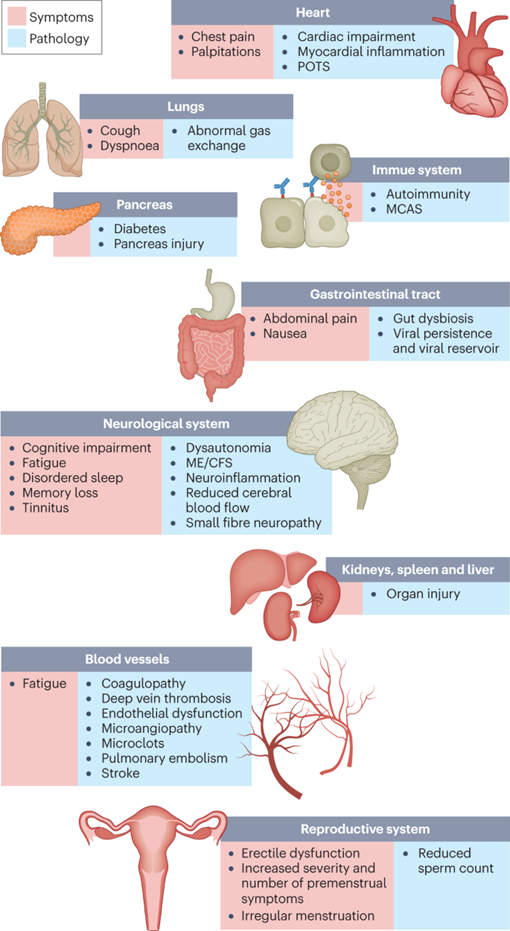COVID-19
Covid is not over.27.03.2023
|
Click on images for a larger version
|
Everyone wants the Covid-19 epidemic to be over. Recently, I was interviewed (Figure 1) and this helped me to clarify the most important questions. Whether an epidemic is relevant or not depends on its impact on mortality and morbidity. So how is the battle against SARS-CoV-2 going doing?
|
Observations:
|
Figure 1. Interview AD. Groene hart. 25.03.2023.
|
1. Excess mortality remains high.
Excess mortality rates in Europe have been around 10-12% in 2020, 2021 and 2022. It seems reasonable to expect similar numbers for 2023. Generally, the gradient goes from North to South to East Europe, with the Netherlands, as an exception, being hit harder than even South-European countries. Excess mortality was similar in all age groups (Figure 2), and this lead to an unprecedented decrease life expectancy in most countries (Figure 3). In the first two years, Covid-attributed mortality was the direct cause of excess mortality, excess mortality in 2022 will be discussed further on.
|
Figure 2. Absolute mortality and relative excess mortality (orange with percentage) per age group.
|
Figure 3. Changes in life expectancy since the 1960s
|
2. Long-term health effects.
Sick leave varies within each year but has had an increase from about 4% before the epidemic to 5 – 5.5% in 2020 (Figure 4), indicating that the epidemic severely affects health. The increase has been most strong in the long-term sick leave from 3 months to 2 years. The increase in sick leave was strongest in people that have frequent contacts with other people. Many thousands of people have become labour incapacitated due to covid, which results in loss of productivity and could result in huge financial claims.
The main causes of lethality due to acute Covid-19 are cardiovascular disease and immune dysregulation. SARS-CoV-2 infection also have significant long-term health effects i.e., Long covid, with many different symptoms and pathologies (Figure 5). Risk factors and severity of Long Covid do not match those of acute covid, more females are affectedd and the effects of age and BMI are less strong. The P4O2 Long Covid study for personalized medicine shows difference subgroups related to sex and age having different symptoms, like cardiovascular and lung disease.
Long Covid has many different causes: (a) severe tissue damage in lungs and brains, (b) persistent virus infection, (c) autoimmune responses, (d) immune dysregulation, (e) micro clots causing cardiovascular disease, and (f) reinfections (Figure 6). This could explain why Long Covid symptoms vary strongly and could even increase in time. Immune dysregulation might cause various opportunistic infections, including Aspergillus (opportunistic fungal infection known from AIDS). The cardiovascular pathology in Long Covid is strong, causing delayed mortality, that is not registered as Covid mortality.
|
|
Figure 5. Long-covid symptoms.
|
3. Infections cause mortality and morbidity.
Life expectancy decreased in countries with many SARS-CoV-2 infections (Figure 7), but not in strict containment countries like Japan & South Korea (Figure 8). Some countries mitigated with test-trace-isolate, while others opted for lockdowns. Interesting detail, during the epidemic China's life expectancy rose above that of the US. SARS-CoV-2 elimination, not mitigation, creates best outcomes for health, the economy, and civil liberties.
Although it has been argued that anti-epidemic measures are associated with negative psychological effects, these cannot be found at the population level. The strongest effects on depression and anxiety are related to severity of disease in significant others (Figure 9).
Symptoms of respiratory infections are, just like hay fever, most strongly related to the immune response against the virus, and not the causative agent itself. Viruses have an evolutionary advantage if they can infect people before causing symptoms, since diseased people tend to isolate themselves. Therefore, it is little surprising that the highest virus titers are found 3 to 1 days before symptoms, or even in infected people never having symptoms. This illustrates that testing is a very important to reduce contamination, and it widely recommended by the WHO and even personal opinion of experts (Figure 10). Testing is an essential part of fighting epidemics.
|
Figure 9. Influence of severity covid in close friends and family members on psychological well being.
|
Figure 10. Marion Koopmans, a prominent advisor of the Dutch governent, privately tests herself before visiting her elderly parents, even if she is without complaints.
|
4. Vaccinated people stay healthier.
The main purpose of vaccination is to protect from disease and the Covid (RNA) vaccines are very effective in this. It should be noted that to control the spreading the virus, vaccination is not the right tool, because coronaviruses do not yield sterilizing immunity.
Immunity after vaccination is good, and the risks are very limited. Unfortunately, immunity after vaccination or infection with coronaviruses is only short lasting. Infection has too many side effects to be a good strategy to yield immunity (Figure 11), illustrating that herd immunity will never be achieved.
Immunity after vaccination is good, and the risks are very limited. Unfortunately, immunity after vaccination or infection with coronaviruses is only short lasting. Infection has too many side effects to be a good strategy to yield immunity (Figure 11), illustrating that herd immunity will never be achieved.
Antivaxxers have been strongly campaigning against vaccination with conspiracy theories, spreading fear about the Spike mRNA, without saying that SARS-CoV-2 has the same mRNA as the vaccines together with proteins that copies the mRNA, and proteins that undermine the immune system. The incidence of serious vaccine side effects (1:10.000 to 100.000) is far less than the observed excess mortality. Analysis of 35 individual people dying after vaccination, gave no indication of any clear-cut vaccine-induced fatalities. No mortality was observed in young people, and fatal causes could be easily attributed to other causes. Comparisons between countries (Figure 12) and between vaccinated and unvaccinated people within a country (Figure 13) showed that vaccination protects from mortality.
Infection increases the risk of fatal cardiovascular disease, including heart failure, stroke, atrial fibrillation, myocardial infarction & venous thromboembolism (VTE). The data show that vaccination protects both against direct mortality due to infection and delayed mortality due to cardiovascular disease (Figure 14) triggered by Covid.
Infection and vaccination have different effects on the immune system as viruses has various strategies to avoid neutralization by the immune system. Certain strong anti-SARS-2 immune responses are associated with severe COVID-19. Severe Covid is caused by infections provoke potential lethal, strong and aberrant immune responses. This might cause autoimmunity, and too strong immune reactions cause feedback mechanisms that down regulate immune responses, which might cause persistent infection. Vaccination prevents these pathological responses. The pathological immune responses are associated with dangerous immune cell activation and thrombocytes that could lead to cardiovascular disease. Repeated vaccinations with mRNA vaccines reduce the harmful immune response.
|
Figure 11. Infection has far more risks than vaccination.
|
Figure 12. Vaccination of 60+ population is negatively associated with their loss of life expectancy.
|
5. The impact evolves to continue.
Hosts and viruses are constantly evolving in response to each other: as a host attempts to suppress a virus, the virus attempts to evade and suppress the host's immune system. Viruses and the immune system are involved in an arms race. Some people suggest that viruses tend to become milder in the field, but solid evidence is lacking. Often, it is referred to myxoma virus in rabbits, that used to kill over 90% of European rabbit populations in Australia. However, careful evaluation showed that the virus hardly changed its virulence, but that in Australian rabbits were selected to be less sensitive for the virus.
Mutations mostly increase the virus virulence. Most viruses evolve to reproduce faster, which is often associated with more severe disease. This has been observed for RNA viruses such as Zika virus, Ebola virus, West-Nile virus, Dengue virus, Poliovirus, and Enterovirus-71. Another example is HIV, the causative agent of AIDS, where there is a strong selection towards faster reproduction. The quasi-species population of RNA viruses could be a key contributing factor to increased virulence. If evolution will change the cause of Covid, it is most likely that a more pathogenic variant of SARS-CoV-2 will appear.
Coronaviruses have a proof-reading RNA polymerase that minimizes copy errors, and thus will evolve more slowly than other RNA viruses. However, adaptation to a milder pathogenic strain seems very unlikely. The observed improved outcomes of infections are mainly due to stimulating the immune system by vaccination and better therapeutic interventions.
6. Fighting the endemic?
The epidemic has moved into an endemic phase with the same impact as the epidemic phase before. After all, endemic only means that the virus circulates at similar levels through the population, but it is not an improvement of the healthcare situation. Endemic Covid shows 10-12% excess mortality in West-European countries, with the highest excess in the Netherlands. Currenlty COVID-19 causes the lost of the most life years: 180,000 in 2021 (Figure 15). I would predict a similar excess mortality for 2023 e.g., 15.000 deaths on a population of 18 million. Under influence of the conspiracy thinkers of ‘truth and love’, the Dutch policies has been trapped in false dichotomies between science and pseudoscience.
So how do we fight an endemic? Not with lockdowns, since they should be a last resort for fighting epidemics and are completely overkill for endemic phases. Sustainable strategies ask for a combination of measures to reduce (the impact of) infections at minimal costs and inconveniences for the society.
Suitable strategies are vaccination (once or twice per year), testing before meeting vulnerable people or even large groups, better ventilation, and/or keeping distance. Policy makers should communicate these measures as wisdom out of care and love for each other, but in situation of large impact, like hospitals and nursing homes, enforcement might be needed.
Lying and to let people die is an act out of neither truth nor love, that traps the society. Caring for others is done out of factual truth and real love that provides a healthy freedom for everyone.
Most important causes of lost in lfe years (NL).
John Jacobs
27.03.20223
27.03.20223


















